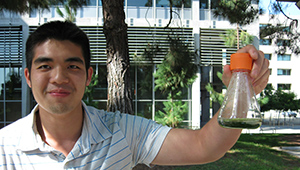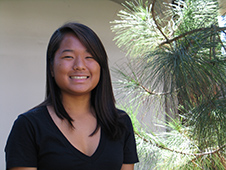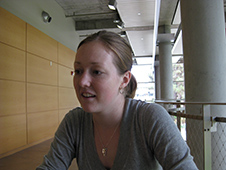Eureka! Program Gives Undergrads Chance to Trade Summer Jobs for Opportunity to Conduct Hands-on Research
September 29, 2008
By Susan Brown

Francis Hwee holds a flask of cyanobacteria, which he is trying to modify to make useful drugs
Francis Hwee bounds into the room waving a flask filled with emerald green cyanobacteria. Rather than managing an apartment building in Oakland, Hwee spent his summer trying to coax the microorganisms into making precursors of drugs that could fight malaria or cancer with the help of a scholarship from the Division of Biological Sciences.
Four undergraduate students who might otherwise have taken summer jobs unrelated to their studies received the $3,500 awards this year through a program called Eureka!, which also brings local professionals to campus, and students on industry tours, to help biology majors learn of the full spectrum of job opportunities available in the field.
The scholarship gave Hwee the chance to work with biology professor Steve Briggs on converting cyanobacteria into living drug factories by introducing genes borrowed from plants. To improve yields, Hwee pasted the DNA for the useful plant proteins together with a genetic sequence from yeast called TEnBox, which boosts the productivity of nearby genes.

Darrell Tran studied a gene that may help fruit flies make a steady supply of sperm
That process is not quite a simple as it sounds. "A lot of moments, you really want to pull out your hair," Hwee said. But a trial run introducing the foreign metabolic program into the standard lab bacterium E. coli was a success. When he separated the proteins that would be useful for making drugs from others, "we actually saw a fat gob," Hwee said. "Now we know for sure that our TEnBox sequence works. That gives us hope" for genetically engineering the cyanobacteria. Unlike E. coli, which need special food to do their work, cyanobacteria gain energy from photosynthesis and will thrive on wastewater and sunlight.
Darrell Tran's moment of insight came when he looked through a microscope and saw nothing. Looking at the testis of a fruit fly, he expected to see a group of cells called the hub, which help surrounding stem cells retain their ability to continually replenish the supply of sperm.

Jessica Fujimoto helped to breed mice to study the immune system this summer
Normally "there's a red patch of 12 or so cells in a little ball," Tran said. But when he blocked a gene that he suspected might be helping to maintain the stem cells the hub disappeared. "You see no stain at all, there's nothing there," he said. Tran will continue his work with Leanne Jones, who holds an adjunct appointment at UCSD, at the Salk Institute for Biological Studies this year.
Jessica Fujimoto has also already returned to her summer project with assistant professor of biology Ananda Goldrath helping to create "double knockout" mice by disabling two separate genes. The mice will allow the team to sort out how the genes contribute to immune system health. "I'm really grateful I got this," said Fujimoto, who would have found a job in retail without the Eureka! scholarship.

Lisa Geary demonstrated that a particular molecule helps to raise an immune response to infection
Lisa Geary would have spent her summer working in adjunct professor Carl Ware's laboratory at the La Jolla Institute for Allergy and Immunology anyway, but as an assistant. With her own money in hand, Geary took off for Philadelphia right after spring classes ended for a week-long professional course in immunology.
The course helped Geary take charge of an independent research project. "Now I can come up with my own ideas," she said. Her work required long days and steady concentration. "You have to be very precise and keep your head in the game the whole way," she said.
Late on a Sunday at the end of the summer, Geary finally saw evidence that the molecule she was studying helped to raise an immune response to infection, she said. "To see the results, to know that it really paid off, that was exciting."
